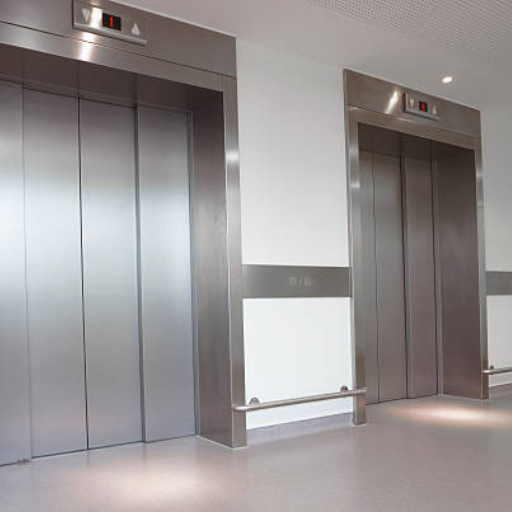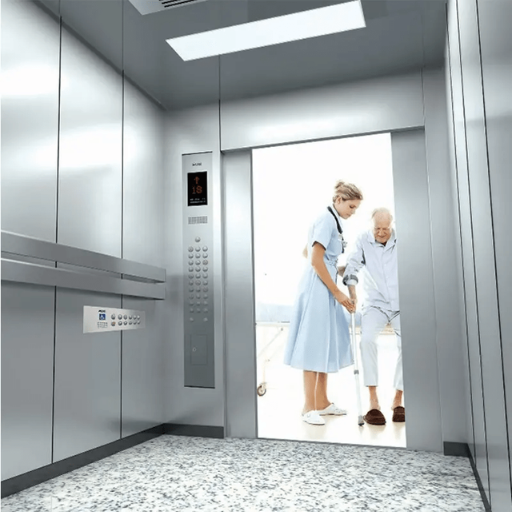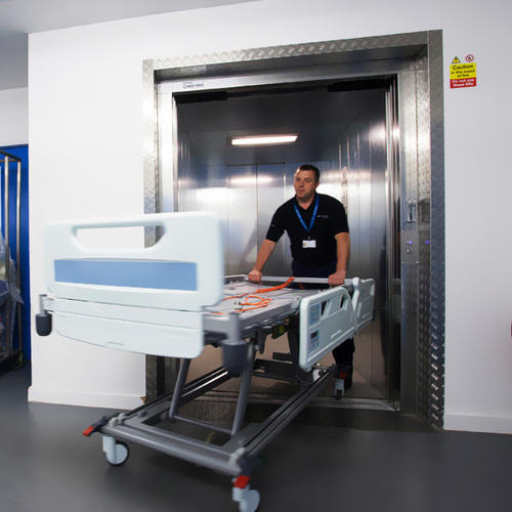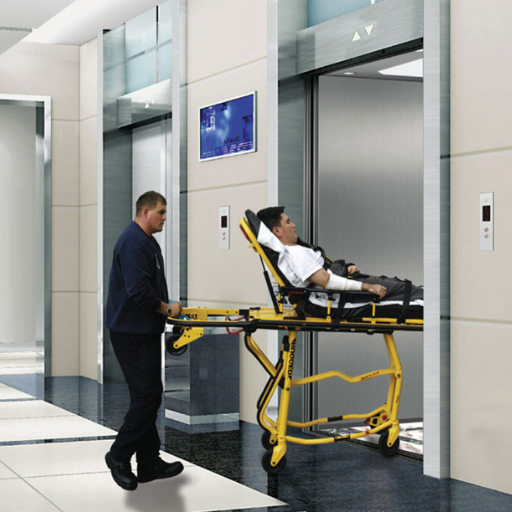When it comes to hospital infrastructure, elevators play a crucial role in ensuring the efficient movement of patients, staff, and equipment. Choosing the best elevator system for a hospital requires careful consideration of several factors including safety, reliability, speed, and capacity. This blog aims to provide comprehensive insights into the different types of hospital elevator systems, their features, and the criteria for selecting the most suitable one for your medical facility. By drawing on expert opinions and industry standards, we will explore how to optimize the functionality of hospital elevators to enhance patient care and operational efficiency.
What Are the Main Types of Hospital Elevators?
Understanding Traction Elevator Systems for Hospitals
Traction elevator systems are the most frequently used in hospitals because of their effectiveness and reliability. Ropes and weights power these systems which move the elevator car by means of a motor. They are suitable for tall hospital buildings as they have better speed of travel and can carry more people than other types. For safe transportation of patients and delicate medical apparatus, traction elevators can be fitted with advanced control systems that help them to come to a stop smoothly and accurately. In addition, they are economical on power and require less maintenance compared to hydraulic elevators, making them reasonable choices in hospitals.
The Role of Hydraulic Elevators in Healthcare Facilities
Hydraulic elevators also commonly find their application in healthcare sector specifically for low-to mid-rise hospital facilities. These systems employ a hydraulic ram to make the elevator car rise while fluid pressure propels it upwards. One key benefit of hydraulic elevators is their ability to handle heavy loads, making them ideal for transporting large medical equipment and multiple patients with ease.
Technical Parameters of Hydraulic Elevators:
- Load Capacity: Typically up to 8,000 pounds meaning it can accommodate large medical equipment besides patient beds.
- Travel Speed: Normally slower than traction lifts at approximately 150 feet per minute (0.75 meters per second) which is enough for short-rise applications.
- Maximum Travel Distance: Limited by length of the hydraulic ram hence not exceeding five-seven floors.
- Design Flexibility: The machine room needs to be located next to the hoistway; this could be crucial during hospital planning phase.
Hydraulic elevators can be cheaper during installation process compared to traction ones but might consume a lot energy resulting into high running costs due to electric use when operating and regular servicing needs. Furthermore they operate more smoothly without much noise disturbing patients in sensitive hospital environments. However, hydraulic ones may not be as fast or efficient as those using traction yet they remain reliable and strong enough for most health care settings.
Comparing MRL Elevators and Standard Elevators in Hospitals
Comparing Machine Room-Less (MRL) elevators and conventional lifts in a hospital, there are several aspects to be considered:
Space Efficiency
- MRL Elevators: No separate machine room which implies better utilization of building area. This is particularly advantageous for medical facilities that have limited space as the machinery is contained within the hoistway.
- Standard Elevators: Generally require either an overhead or adjacent machine room thereby compromising flexibility in design while taking up space that could have been used for other functions of the hospital.
Installation and Maintenance Costs
- MRL Elevators: They are often more expensive initially because of their advanced technology and further structural requirements. They have lower maintenance costs over time since they operate with low energies hence reduced electricity bills.
- Standard Elevators: On one hand, installation expenses may be relatively low compared to those associated with MRL systems; however, continued maintenance could become costly especially for hydraulic models due to chances of fluid leaks and servicing demands.
Energy Efficiency
- MRL Elevators: The regenerative drives employed by these elevators make them highly energy efficient thus reducing electricity consumption significantly. As a result, they are an ideal option for hospitals aiming at cutting down operational expenses as well as carbon footprint.
- Hydraulic Elevators: Typically consume more energy and can lead to higher operational costs, although they offer the advantage of handling heavy loads smoothly and quietly.
Load Capacity and Speed
MRL Elevators:
- Load Capacity: Standard traction elevators are similar, usually from 4,000 to 5,000 pounds.
- Travel Speed: Just as with the standard traction elevator, it moves up to 500 ft per minute (2.5 meters per second), thus making them suitable for high-rising hospital structures.
Hydraulic Elevators:
- Load Capacity: Typically holds up to 8,000 pounds of weight and can accommodate huge medical equipment and patient beds.
- Travel Speed: They are typically slow and move at about 150 fpm (0.75 mps) which makes them suitable for low-rise applications only
Maximum Travel Distance
- MRL Elevators: Fit into over twenty floors and hence best suited for high-rise hospital buildings.
- Hydraulic Elevators: Due to ram length limitation, these are limited to five to seven floors hence better suited for low/mid rise structures.
In summary, specific requirements like space available, budget constraints applied on the project, energy efficiency targets set by the facility’s management or operations carried out in such an institution should be the main concerns when deciding whether MRL or conventional systems should be installed.
How to Choose the Right Elevator for Your Hospital?
Considering Patient Care and Transport Needs
When choosing hospital lift, the patient care and transport needs should be the focus. Hospitals require lifts that address the safety, comfort and expediency of transporting patients.
- Safety and Reliability: The elevators to be chosen must be safety compliant and reliable thus reducing instances of breakdowns hence ensuring patient movement remain uninterrupted.
- Size and Design: The elevators should not cause any discomfort by being spacious enough to hold stretchers, beds, medical equipment as well as personnel. It is good for them to have wide doors that allow for easy entry and exit as well as smooth level stops among other things.
- Speed and Efficiency: Elevators used in critical care should strike a balance between how fast it can move at the same time providing safe transportation of patients within various floors.
- Accessibility: All patients including ones with disabilities need to access lifts easily hence requiring large buttons, audio-visual signals among others.
- Energy Efficiency: This saves on energy bills in hospitals while allowing more funds to go into patient treatment rather than operational costs.
Taking these into account will aid in picking an elevator system that enhances patient care while taking into consideration the needs of operating in a hospital environment.
Evaluating Medical Lifts for Specialized Needs
In evaluating medical lifts for specialized needs, precision, flexibility, hygiene are some of the factors to consider.
- Precision and Control: Medical lifts must have controls systems which can provide precise control during transfers so that they can keep patients safe. Advanced models possess controlled movements which are crucial for patient comfort as well as security purposes given their adjustable speeds too.
- Flexibility and Adaptability: The best medical lift is one that can work in different settings or with different groups of patients. These types of machines work with all types of slings, support patients who weigh many pounds, operate anywhere else in the hospital’s premises etcetera thereby making them very elastic.
- Hygiene and Maintenance: Health standards have to be maintained high in a hospital. Cleaning of medical lifts should be easy and have parts that won’t get contaminated. There should also be regular maintenance schedules as well as availability of spare part and service.
These factors are consistent with the most recent recommendations from top healthcare equipment suppliers making sure that medical lifts meet their specific requirements efficiently and effectively in modern hospitals.
Understanding Code Requirements and Regulations
Knowing the code requirements and regulations on medical lifts is necessary so as to comply with both local and national standards. The present guidance underscores observance of the following key areas:
- Safety Standards: Organizations such as ANSI (American National Standards Institute) and ISO (International Organization for Standardization) stipulate safety standards that these special lifts must adhere to. These standards focus on mechanical, electrical safety, and minimizing patient risks during transfer.
- Accessibility Compliance: American Disability Act (ADA), ensures all people can access health care services by providing guidelines including those for lift design, functionality, installation etc. ADA compliance ensures that every type of patient can be served by using medical lifts even if they are disabled hence equitable provision of health care services.
- Inspection and Certification: Regular inspection and certification as required by regulations such as OSHA is important. These inspections ensure operational functionally of medical lifts so that they do not cause any problem when being used hence ensuring that there are no risks involved in carrying out these activities.
Hospitals and healthcare facilities that follow these rules will be able to make sure their medical lifts are safe, accessible, and efficient.
What Are the Key Features of Hospital Elevators?
Major Hospital Lift Safety Measures
Hospital elevators are a must-have in the operation of healthcare facilities, and this article lists down a number of important safety features that should be taken into account when designing them:
- Backup Power Systems: These systems ensure continuity during power outages to prevent patients, staffs and visitors being trapped or disrupting any critical transfers.
- Emergency Communication Systems: Such two-way communication systems are found in hospital lifts to assist when there is an immediate need. This allows direct contact with emergency teams or security officers.
- Nurse Control Overrides: Disease outbreaks necessitate uninterrupted patient transportation; hence, these lifts may have nurse control overrides installed. By pressing the priority button on the panel placed inside the cabin, a nurse can bring the elevator directly to his or her floor regardless of which other floors it was previously serving.
- Anti-Microbial Surfaces: Anti-microbial surfaces in hospital lifts help reduce rates of cross-contaminations thereby creating a sterile atmosphere that is good for patients’ health.
- Smooth and Level Floor Transitions: Proper alignment of elevator floors with building ones reduces chances for tripping and falling and enhances safe transport for patients as well as easy movement of medical equipment.
Hospital lifts that are integrated with these aspects yield more efficient services while improving safety for both patients and workforce within these institutions.
The Essential Components of Elevators in Hospitals
Elevator fixtures and controls have significant importance on how well hospital elevators operate safely. Some key fixtures and controls include:
- Call Buttons and Indicators: Call buttons located on every floor and also inside the elevator allow one to call for it. The illuminated indicators show whether it is occupied, its direction of travel or its current position.
- Floor Selection Panel: Within the lift, users can select their desired floor through this panel. It will often consist Braille for visually impaired people using tactile buttons on either side to press either up or down – plus emergency stop buttons if needed.
- Alarm and Emergency Stop Buttons: Safety requirements have to be met by all lifts. This button assists to call the nearby staff during emergency while the emergency stop one instantly stops the elevator in case of any malfunctioning or danger.
- Intercom System: This intergrated communication system is crucial as it allows passengers to communicate with security or maintenance personnel if necessary.
- Digital Display Screens: Modern elevators come with digital screens that display up-to-the-minute information such as floor level, direction of motion and emergency messages.
These facilities are essential for hospital elevators to function smoothly and safely under the demanding conditions of a healthcare setting.
Customizing for Patients’ and Staff’s Convenience
To fit into patient and staff needs, there should be some customization in hospital lifts. Some critical ones include:
- Size and Capacity: Hospital beds, stretchers, medical equipment and multiple passengers must be accommodated by spacious lifts at the same time. This ensures patients flow more efficiently along with reduced queuing times.
- Speed and Efficiency: In emergencies fast elevators are crucial for quick movement between floors with patients as well as medical personnel. Elevator systems work on efficient dispatch mechanisms that minimize travel time also optimizing elevator availability.
- Sanitization Features: To maintain a sterile environment, elevators are equipped with antimicrobial surfaces, air purifiers, touchless controls aimed at controlling cases of healthcare-associated infections which have been rising alarmingly in recent years.
- Accessibility Features: For the sake of inclusiveness when it involves all persons regardless of their status, voice announcements are made in these lifts; tactile buttons find their place on the control panel while lower control panels will come handy wheelchair users. These improvements adhere to ADA rules hence fostering a barrier-free building.
- Service Functions with Priority: Elevators can be set to have priority service for medical personnel, emergency services, and equipment transport. This is a feature that prevents undue delays during emergencies.
These are customizations intended to make hospital elevators more convenient and secure, taking into account the unique requirements of health care facilities.
How Is Elevator Installation Conducted in Healthcare Buildings?
Engagement with doctors and building managers
A lot of coordination must be done between a medical team and a building manager for the installation of elevators in healthcare buildings to be successful. This approach ensures that construction processes do not interfere with normal hospital services. The initial meetings are mainly concerned with understanding the specific needs of the health facility such as patients’ types, and critical areas where elevators are needed.
On the other hand, medical personnel offer invaluable insight about operating requirements including peak hours for patient movements, emergency procedures, and sanitization protocols. Correspondingly, contracting officers work closely with managers to schedule phases of construction that coincides with workflow at the plant thus averting delays while maintaining safety. In order to address any concerns promptly, communication channels are established which allow for adjustments in project timelines if need be.
As such an efficient execution is ensuring that elevator installations meet all regulatory requirements while ensuring there is continuous provision of patient care.
Ensuring A Smooth Merge Of Hospital Elevators
To make sure that hospital elevators can smoothly integrate various steps must be taken into account One crucial step involves aligning construction timetable with daily operations at the hospital so as not to interrupt them. This frequently includes working during off-peak hours or using soundproofing techniques. Secondly, it is essential to have very tight sanitary standards when installing them so that they will not pose any health hazard for those who use them; this therefore calls for their cleanliness and safety features in terms of emergency evacuation systems as well as design aimed at avoiding contact transmission infections. Additionally integration should occur between existing elevator systems and health centers systems like electrical and HVAC system’s making sure there is a uniform flow throughout the entire unit. Lastly, robust training programs are conducted among all medical personnel on how to utilize these machines effectively especially during emergencies Ensuring these steps provides a seamless integration that enhances the hospital’s operational efficiency while maintaining the highest standards of patient care.
What Is Involved in Elevator Maintenance and Modernization?
Daily Inspections and Maintenance Procedures
When it comes to hospital elevators, regular inspection and maintenance are vital for safety and reliability. I am focusing on a comprehensive routine that has visual inspections, functional tests, and preventive maintenance tasks. These checks are done daily in order to look into the control panels, emergency systems, mechanical components of the elevator for proof of wear and tear or malfunctioning. I conduct more detailed examinations monthly where I check on alignment lube moving parts and integrity of hoistway. A thorough examination is carried out annually to ensure that all applicable safety standards and regulations are met. This pre-emptive servicing approach helps prevent unforeseen breakdowns, lengthens the lifespan of the equipment, while ensuring continuous safe patient-staff service.
Advantages of Elevator Modernization within a Hospital Set-Up
Several benefits result from modernizing elevators in hospitals which directly affect operational efficiency as well as enhancement of patient care. The most important one is reduced downtime as well as interruptions in services; this allows quick transportation for patients to their destinations with fewer inconveniences caused by failure of the lift systems . Besides advancing safety and reducing power consumption through updating control devices and drive mechanisms, elevator modernization aids significantly in lowering operational costs thus leaving less carbon footprint at the facility (Pierre 2006). Furthermore changing to high-tech models enhances speed or ride quality which is very essential especially during emergencies where seconds really count. In addition it ensures compliance with current safety rules plus regulations making both patients and staff comfortable about what they use. All these changes go a long way in improving everyday operations in hospitals hence enhancing healthcare provision.
Efficient Operation And Management Of Elevators
Hospital elevator operation should be efficient so management should follow certain steps. Firstly there must be an intensive maintenance program comprising day-to-day inspections that can lead to early detection plus timely correction before grave damage happens . In addition, routine upgrades in technology are essential to improve efficiency, safety and energy use. Similarly the hospital staff must be trained on how to use lifts and the procedures that come with any emergency cases so as to avert dangers while at the same time being able to intervene promptly (Mihelcic et al., 2003). These factors working together guarantee uninterrupted flow of movement of patients and other users which is one of the main contributors to efficient running of its operations thus safer health care environment.
Reference sources
-
ASM International – “Tool Steels” Handbook
- This handbook from ASM International provides a thorough examination of tool steel types, grades, properties, and applications. It is a highly authoritative source for in-depth technical information.
- Tool Steels Handbook by ASM International
-
Carpenter Technology Corporation – Technical Articles on Tool Steels
- Carpenter Technology offers a range of technical articles and datasheets that explore the different types of tool steels, their specific grades, and practical applications in industry.
- Technical Resources from Carpenter Technology
-
-
Fushun Special Steel – “Most Common Tool Steel Grades with Applications”
- This article discusses the most common groups and grades of tool steels, including water-hardening, cold-working, shock-resisting, and high-speed tool steels, along with their specific applications.
- Most Common Tool Steel Grades with Applications
-
Frequently Asked Questions (FAQs)
Q: What features should modern hospital elevators have?
A: Hospital elevators are designed with unique specifications that cater for healthcare facilities. This entails large elevator cabs to accommodate stretchers, wheelchairs, and medical equipment; smooth and speedy vertical transportation; floor leveling for easy access; air purifiers for hygiene purposes; and reliability to ensure no down time.
Q: How do hospital elevators differ from common elevators?
A: In contrast with ordinary lifts, hospital elevators are constructed according to strict guidelines to suit such environments. They have bigger interiors of the elevator cab, more accurate floor leveling, higher weight capacity and advanced air purifiers used for cleanliness. They also contain specific options like destination dispatching which engage routes optimization for healthcare professionals only.
Q: How does the cost of a hospital elevator compare with that of a standard one?
A: The cost of installing an elevator in a hospital is generally higher than that of standard ones because there will be special requirements like larger elevator cabs, advanced safety systems and enhanced durability to deal with high traffic volumes as well as frequent use. Some customization like air purifiers or gearless system can also increase its price tag.
Q: Are escalators found in hospitals, how do they relate to lifts?
A: There are indeed escalators in hospitals specifically placed in high traffic zones such as lobbies and main corridors. Doing so helps integrate both the elevator and escalator systems thus ensuring proper movement of staffs, patients and visitors efficiently. However, this is mainly used by patients on stretchers or carrying medical equipment moving between floors unlike stairs.
Q: What are the most common types of hospital elevators?
A: The most typical examples include passenger lift/elevators service lift/elevator bed/stretcher lifts/bedlifts.Their objective is based on either mobility needs of passengers ,carrying medical supplies or transfering patients safely from one floor to another.
Q: What is the process of executing an elevator project in a hospital?
A: An elevator project in a hospital has several stages such needs analysis, design development for hospital lift dimensions, selection of appropriate vertical transportation solutions, installation and testing, and maintenance services after that. These steps ensure that the new elevator meets operational and safety requirements necessary for health care facility.










